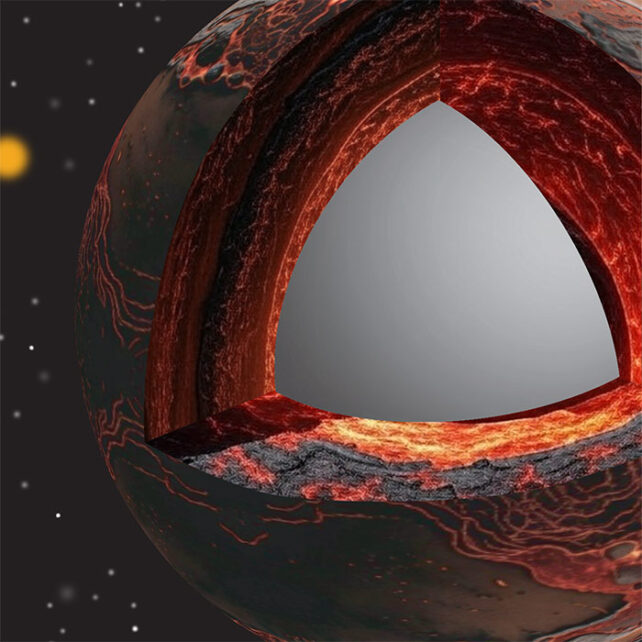One of the strangest mysteries about our Earth is the presence of two dense, giant blobs inexplicably clustered above the planet's core.
Now, new models might reveal where they have come from, and it's neither of the expected origin stories. Rather, some material may have oozed from a leaking core when Earth was newly formed eons ago, and mixed with the mantle to create the so-called large low-shear-velocity provinces (LLSVPs) we see today.
"These are not random oddities," says geodynamicist Yoshinori Miyazaki of Rutgers University. "They are fingerprints of Earth's earliest history. If we can understand why they exist, we can understand how our planet formed and why it became habitable."
Related: Earth's Inner Core Is Mysteriously Changing Shape, Study Reveals
The two LLSVPs were discovered in the 1980s in seismic data collected from earthquakes. This data showed the presence of two large regions in Earth's lowermost mantle, one under Africa and the other under the Pacific Ocean. They extend upwards from the core-mantle boundary, which sits around 2,900 kilometers (nearly 1,800 miles) below Earth's surface.
Through these patches, the seismic waves travel with distinct sluggishness, implying a different composition from the surrounding material.
Scientists have previously proposed varying explanations, including remnants of old tectonic slabs, a cooling magma ocean, or chunks of a giant object named Theia that once collided with Earth to make the Moon.

These blobs aren't just a curiosity. The African blob, in particular, has been implicated in a weakening of Earth's magnetic field over the Atlantic Ocean. Some scientists think that the blobs played a role in the formation of Earth's tectonic plates.
What they are, and how they got there, may be tied to the way our planet evolved and how it behaves now, with different possibilities meaning different things for that evolution and behavior.
One recent study found that the blobs are very old and stable, which is consistent with the magma ocean theory.

According to this theory, Earth was a molten, squishy ball covered by a magma ocean just after it formed. As this ocean cooled, it differentiated, with the heavier materials separating out and sinking down.
This is supported by the presence of another kind of structure – thin patches at the boundary between the core and the mantle known as the ultra-low velocity zones (ULVZs), which correlate with the edges of the LLSVPs where seismic waves travel up to an order of magnitude more slowly than they do through large low-shear-velocity provinces.

For the magma ocean theory to be correct, Earth would need to have nice, neat, strongly defined layers like a cake, with a layer above the core-mantle boundary consisting of a decent amount of ferropericlase. However, seismic data indicate a much lower ferropericlase content, while the very presence and messily piled configuration of the LLSVPs and ULVZs contradict this model.
"That contradiction was the starting point," Miyazaki explains. "If we start from the magma ocean and do the calculations, we don't get what we see in Earth's mantle today. Something was missing."
So the researchers conducted modeling to determine what was missing. They mixed up the basic ingredients for Earth and simulated how they cooled, with and without material leaking from the planet's core. That revealed the secret ingredient.
Not every element cools and crystallizes at the same rate. As the core cools and shrinks under pressure, according to the models, lighter components such as magnesium oxide and silicon dioxide crystallize more readily than the iron in the mix. These float upwards and get squeezed out across the core-mantle boundary into the magma ocean, where they dissolve.
From there, this added material shifts the magma's chemistry in a way that favors the formation of silicate-rich bridgmanite and seifertite, which then dominate the bottom layer while ferropericlase levels remain low.
Even deep inside the planet, where temperatures and pressures rage to extremes, these structures can persist over the 4.5-billion-year lifespan of Earth, gradually swept together by convection into the pile structures that scientists discern in seismic data today.
That's sort of amazing, and puts the magma ocean back on the table as a plausible explanation for these large, dense chunks buried deep beneath Earth's surface.
And if the LLSVPs and ULVZs played a role in the formation of tectonic plates that are so vital to Earth's habitability, it might tell us something more about how other planets evolved differently.
"Even with very few clues, we're starting to build a story that makes sense," Miyazaki says. "This study gives us a little more certainty about how Earth evolved, and why it's so special."
The research has been published in Nature Geoscience.

